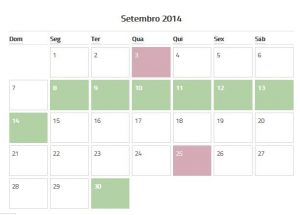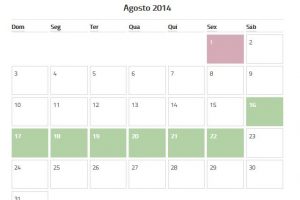The fertile window is the period of time when it is possible to get pregnant1. This period is characterized by ovulation, and its duration varies from woman to woman. Since there are two fixed phases within the menstrual cycle (the follicular and the luteal), it is necessary, first of all, to have prior knowledge about the regularity of your cycle and when the fertile window occurs. To help those trying to conceive identify this moment, the fertile window calculator was created.
The fertile window calculator cannot provide the exact day of ovulation or the fertile window; it is simply a prediction. This is because every woman’s body is different, and this tool uses a standard calculation. A tip: if you want to know the exact day of your ovulation and your fertile window, it is best to use ovulation tests. Ovulation tests work similarly to pregnancy tests. With a small urine sample, it is possible to determine whether ovulation is near or happening.

To get pregnant, a woman needs to be in her fertile window. Outside of it, the ovulation calculator (as it is also called) won’t be useful. It aims to show exactly, in cases of regular cycles, or approximately, in cases of irregular cycles, when a woman is fertile and able to conceive or, if she does not wish to get pregnant, when to avoid intercourse.
Women ovulate around the 14th day of the menstrual cycle. This count should be made from the first day of menstruation, and to be sure, the fertile window can be considered as two days before and after.
This happens due to the synchronization of hormones in the body; the pituitary gland releases hormones at the right time for ovulation to occur, and that’s where the fertile calculator comes in. It helps detect these days that are more likely for pregnancy.
How to Calculate the Fertile Window?
It’s very simple, just enter the number of days in your cycle and the date your last cycle started, and that’s it. To calculate the fertile window, the fertile calculator is based on a stable cycle with exact days, but it can at least provide an estimate of fertile days in an irregular cycle, and this is a big help for those trying to conceive. Normally, a cycle can last from 21 to 40 days, and women with short cycles of 21 days have a much shorter follicle stimulation phase than women with longer cycles of around 35 or 40 days.

The pre-ovulatory phase is what changes, and the variation lies in the time a woman has for the maturation of follicles stimulated by FSH and estrogen. The post-ovulatory phase usually has more exact days, sometimes 11, sometimes up to 16 days. Calculating the fertile window can become difficult for most women precisely because of day-to-day variations in the cycle. For this reason, we recommend, to make this control easier, the use of ovulation tests, which can accurately detect the approach of ovulation as well as when it is already happening.
Signs of Ovulation
Women with irregular cycles should pay attention to the signs the body gives when ovulating, which are basically:
- Mucus
- High temperature
- Increased libido
- Pain or twinges on one or both sides
The signs, together with the ovulation calculator, make the period of trying to conceive easier to identify. Especially in cases of irregular cycles, knowing the days you are probably fertile can lead to a much faster pregnancy. The fertile window calculator also helps women who do not want to get pregnant, as tracking your cycle becomes easier and, in the case of regular cycles, can indeed be an effective contraceptive method. But be aware, it only works for cycles like clockwork.
Based on the signs your body gives you, such as the number of cycle days and also mucus that shows the period is approaching2, the fertile window calculator acts as an assistant. For women who have difficulty identifying their fertile mucus or who have low cervical mucus production, which affects lubrication, there are also lubricating gels with a neutral PH and consistency similar to a woman’s natural lubrication. Famivita’s FamiGel has all these characteristics. The absence of mucus hinders sperm from reaching the egg, and FamiGel helps in this role.
Women who have busy professional lives or husbands who travel a lot can also rely on the fertile calculator to schedule dates to be together when ovulation is about to happen, making it easier for the couple to conceive. It’s worth mentioning that it can also help pregnant women who don’t know when conception took place. Just remember the day of your last menstruation and the ovulation calculator can give an approximate date for your baby’s conception.
Research on the Fertile Window
To find out how much Brazilian women know themselves, Trocando Fraldas conducted a survey with over 12,000 participants from all over the country between August 2 and 7, 2017 through a questionnaire on their website. The responses were given voluntarily and also included the participant’s location and maternal status.
Questions
The following questions were asked after collecting geographic data from the interviewees:
- When can a woman get pregnant?
- Did you know the term fertile window before getting pregnant?
- Do you know the length of your cycle?
- How would you describe your menstrual cycle?
- Do you know how to determine your fertile window?
Results
For comparison purposes, the answers to all questions except 4 were also converted to numbers, such as “yes” equals 1 or “no” equals 0.
When can you get pregnant
- Half of those interviewed do not know that you can only become pregnant close to ovulation.
- Among those trying to conceive, the index reaches 56%.
- Misinformation is higher in the North region, where only 45% of women know when it is possible to get pregnant, and lower in the South, with 53% responding correctly.
- Pará is the state with the least informed public, and only 2 out of 5 women know when they can get pregnant, followed by Sergipe and Mato Grosso do Sul.
- The states of Santa Catarina, Rio Grande do Norte, and Paraná have the most informed population in this regard, with an average of 53-54%.
- Among the capitals, Campo Grande and Palmas have the lowest knowledge with 36% and 39%, respectively.
- In Curitiba with 54% and Belo Horizonte with 52%, women are more informed.
When can a woman get pregnant?
| Ranking of Lack of Knowledge about the Fertile Window by State | |
|---|---|
| 1. | Pará |
| 2. | Sergipe |
| 3. | Mato Grosso do Sul |
| 4. | Tocantins |
| 5. | Acre |
| 6. | Maranhão |
| 7. | Alagoas |
| 8. | Goiás |
| 9. | Amazonas |
| 10. | Paraíba |
| 11. | Mato Grosso |
| 12. | Bahia |
| 13. | Pernambuco |
| 14. | Roraima |
| 15. | Rio de Janeiro |
| 16. | Piauí |
| 17. | Brazil |
| 18. | Ceará |
| 19. | Espírito Santo |
| 20. | Amapá |
| 21. | Rio Grande do Sul |
| 22. | Rondônia |
| 23. | São Paulo |
| 24. | Federal District |
| 25. | Minas Gerais |
| 26. | Paraná |
| 27. | Rio Grande do Norte |
Knowledge about the Fertile Window Before Getting Pregnant
- On average, 41% of those interviewed did not know the concept of the fertile window before getting pregnant.
- This knowledge is more widespread in the South, with 62%, and less in the North, with 53%.
- Women from Santa Catarina and Piauí lead the states in this category with 65%, while in Tocantins, Sergipe and Roraima the share does not reach 50%.
- In Natal and Rio Branco, 2 out of 3 mothers had already heard about the fertile window before getting pregnant, in Boa Vista, Porto Velho and Palmas only between 45 and 48%.
Menstrual Cycle Length
- 55%, or 5 out of every 9 women, know the length of their menstrual cycle, while the other 4 do not.
- The rate rises to 62% among pregnant women and reaches only 51% among women who are not trying to have a baby at the moment.
- The variation between regions is small, with the lowest value in the North at 53% and 56% in the Southeast.
- The state leader is Piauí, where 63% know their cycle, followed by the Federal District and São Paulo with 60% and 58% respectively.
- In Rondônia only 3 out of 7 women know their cycle and in Maranhão and Roraima it also does not reach 50%.
- Among the capitals, Campo Grande stands out negatively with 47%, and Belém and Fortaleza lead with 62%.
How would you describe your menstrual cycle?
Ability to Determine the Fertile Window
- 59% of Brazilian women are unable to determine their fertile window.
- While in the Midwest and South regions, 43% of women can identify their fertile days, in the North only 37% can.
- In the Federal District, women are more able to recognize it, while in Amapá and Rondônia only 1 in 3 can do so.
- Besides women from Brasília, almost half of the women in Natal and Florianópolis can detect the fertile window.
- In Porto Velho, Cuiabá, and Palmas live those less able to do so.
Reader Questions
When does the fertile window end?
The fertile window ends when ovulation finally occurs. The body gives signals that it has happened through a change in cervical mucus, which stops being slippery and transparent and becomes whitish and thick, resembling a moisturizing cream or glue.
If I take birth control pills, do I have a fertile window?
Women who take birth control pills or use any other hormonal contraceptive methods do not ovulate and therefore do not have a fertile window. The hormones in contraceptives are designed to inhibit ovulation and thus prevent a possible pregnancy.
Can I only get pregnant when I am ovulating?
The fertile window gets its name because it is within this time frame that a woman can get pregnant. The egg survives in the body for about 24 hours after ovulation. Sperm, on the other hand, can live for up to about 5 days inside a woman’s body.
Can I have a fertile window right after my period?
Yes, it is possible! For example, if a woman has a short cycle, around 21 days, and menstruates for 6 or 7 days, the fertile window could happen right after the end of menstruation, between days 6 and 10 of the cycle. See Also: Cycle Chart to Get Pregnant – Counting the Days











